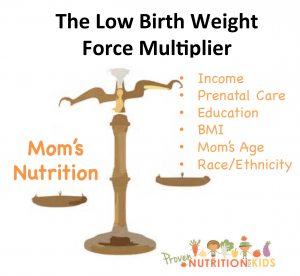The Low Birth Weight Force Multiplier
Here you are, a young mom expecting your first baby. You’re excited and eager to meet this little person growing inside of you. You may even be trying to adjust your lifestyle to be a bit healthier than normal. Or you may be puking your guts out, trying to keep any amount of food down. Either way, you’re probably not thinking about low birth weight issues at this point. You’re just trying to make it through the first trimester.
In the U.S. alone, an average of 8 moms out of 100 will give birth to full-term infants who are starting behind. [1. Rothwell, Jonathan. Starting Behind: Low Birth Weight in The United States. The Brookings Institution. March 4, 2015. https://www.brookings.edu/blog/social-mobility-memos/2015/03/04/starting-behind-low-birth-weight-in-the-united-states/ Last accessed Feb 1, 2017.] These are full-term babies born with a low birth weight. A low birth weight is less than 2.5 kg (or 5.5 pounds).
That 8% number is not talking about preemies who are born early and understandably smaller. These are full-termers who are at very high risk of not making it past their first month [2. Metgud CS, Nail VA, Mallapur MD (2012) Factors Affecting Birth Weight of a Newborn – A Community Based Study in Rural Karnataka, India. PLoS ONE 7(7): e40040. doi:10.1371/journal.pone.0040040]. They are starting out nutritionally and developmentally behind.
Eight percent may not sound like a very high number, but in certain U.S. communities, that risk can reach up to 13% [3. Rothwell, Starting Behind.] In other less-developed countries, like India and Bangladesh, the risk of a low birth weight baby can reach almost 30%.
Certainly, neonatal care in the U.S. has become quite sophisticated and enabled many little ones to survive well past their time of birth. But what if there was something you could do now that would increase the vitality of your baby?
Which Moms Are At Higher Risk?
Numerous studies have been done to determine which moms are at greater risk of having low birth weight infants. And with all the various similarities among moms that birth smaller babies, the issue would seem multidimensional. A mom’s level of education and income play a part, as well as her access to prenatal care and counseling. Her race, age, size and stature can also affect the birth weight outcome of her baby [4. Ibid.] [5. Stanford University. Primary Determining Factors of Low Birth Weight Infants. https://web.stanford.edu/group/virus/herpes/2000/primaryf.htm Last accessed Feb 1, 2017.]
Low birth weight seems like an issue with a complicated solution then. But what if there was one single underlying factor that was common across the board?
What If There Was a Low Birth Weight Force Multiplier?
A force multiplier is that one thing, where if it was changed, it has the possibility to overcome any of the other factors? Indeed, I believe there is one: the mom’s nutritional status. Of the few studies that I read, several of them agree with this as well.
“Perhaps in spite of poor socio-economic status if a woman could maintain a good nutritional status and avoid potential medical complications during pregnancy, giving birth to a normal weight baby might be a possibility.” [6. Kader, M and Nirmala K P Perera. Socio-Economic and Nutritional Determinants of Low Birth Weight in India. N. Am J Med Sci. 2014 Jul; 6(7): 302-308. doi: 10.4103/1947-2714. 136902.]
Another study concludes: “Strategies that combine nutrition-based interventions, such as improving food intakes and micronutrient status, especially iron status, with approaches that improve women’s status and reproductive health are needed to reduce LBW.” [7. Ramakrishnan U. Nutrition and low birth weight: from research to practice.
Am J Clin Nutr. 2004 Jan;79(1):17-21.]
Nutrition is the force multiplier.

- You take an expectant teen mom, increase her nutritional status, and you could overcome the age factor.
- You take an underweight or overweight mom, increase her nutritional status, and you could overcome the BMI factor.
- You take a mom in a poor neighborhood, increase her nutritional status, and she could have a normal weight baby despite her education and income.
The list goes on of possible nutritional interventions.
Now obviously, this list of solutions is easy to write but much harder to implement on a grand scale. Where do you begin?
What’s A Mom To Do?
I think it starts small—one woman at a time. One mom learning how to eat healthy and supplement wisely sharing this with someone else. Perhaps she shares it with a friend one-on-one or in a small group.
Perhaps this first mom is you. Maybe you found my site as you are trying to educate yourself. Now what will you do with what you learn? How will you change your own eating habits? How will you go further and help someone else?
Please share your comments below!




0 Comments